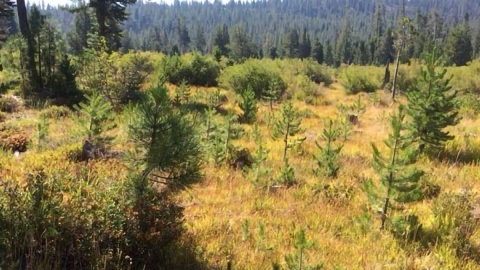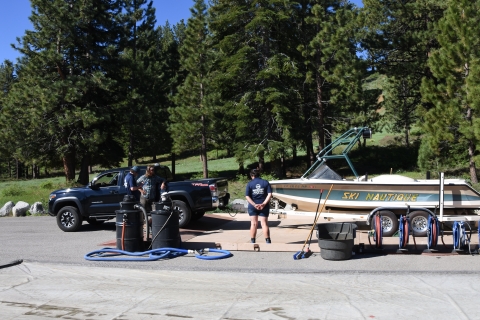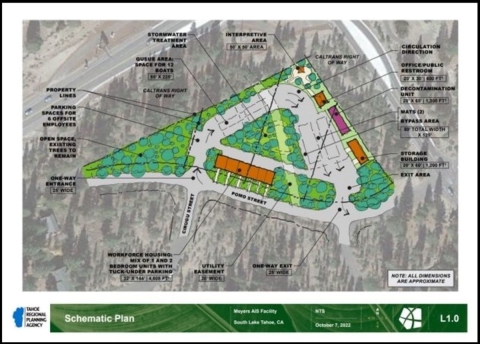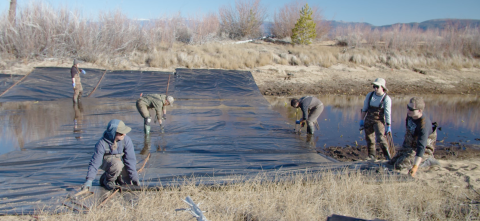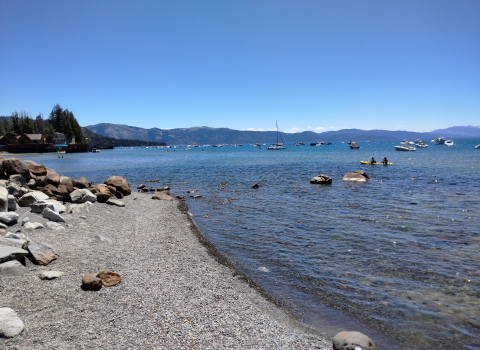The Bipartisan Infrastructure Law was signed in November 2021 and made a historic $17 million investment in the Lake Tahoe Basin. A total of $10.2 million has been dispersed to date supporting collaborative restoration efforts in the Basin.
In the center of Washoe ancestral lands, Lake Tahoe holds significant cultural importance for The Washoe Tribe of Nevada and California and is part of the historic range of Lahontan cutthroat trout, an important food source to the Tribe. To participate in restoration efforts in the Lake Tahoe watershed, the Washoe Environmental Protection Department was established in 1998 and has been a key partner in ongoing restoration work.
Another key partner is the Tahoe Regional Planning Agency, who play a lead role in aquatic invasive species invasive species
An invasive species is any plant or animal that has spread or been introduced into a new area where they are, or could, cause harm to the environment, economy, or human, animal, or plant health. Their unwelcome presence can destroy ecosystems and cost millions of dollars.
Learn more about invasive species management through innovative removal methods, community engagement, and new aquatic invasive species prevention.
The Lake Tahoe Basin faces ongoing threats from the introduction and spread of aquatic invasive species. Common invasive weeds, like the Eurasian watermilfoil, can significantly disrupt aquatic ecosystems and crowd out native species. Aquatic invasive species management is a top priority of the Lake Tahoe Environmental Improvement Program, one of the most comprehensive restoration programs in the nation.
The Service continues to work closely with the Washoe Tribe, Tahoe Regional Planning Agency, and the multi-partner Aquatic Invasive Species Coordinating Committee to identify priority areas for funding under the Bipartisan Infrastructure Law Bipartisan Infrastructure Law
The Bipartisan Infrastructure Law (BIL) is a once-in-a-generation investment in the nation’s infrastructure and economic competitiveness. We were directly appropriated $455 million over five years in BIL funds for programs related to the President’s America the Beautiful initiative.
Learn more about Bipartisan Infrastructure Law .
Increased Engagement by Washoe Tribe of Nevada and California and Máyala Wáta Restoration Project: $1,444,883
The Washoe Tribe of Nevada and California will increase their engagement by providing traditional land management insights into restoration efforts in the Lake Tahoe watershed. Bipartisan Infrastructure Law funds will advance efforts by Washoe Environmental Protection Department to have a greater role in environmental management and to contribute to planning, monitoring and control of aquatic invasive species from a Washoe Tribe perspective.
Washoe Environmental Protection Department staff will also contribute to removal of nonnative fish species and to monitor and advance the recovery of native fish species, especially Lahontan cutthroat trout and whitefish.
Máyala Wáta Restoration Project
Meeks Bay is a traditional summer camp for the Washoe Tribe and holds traditional and cultural value to the Tribe. Meeks Meadow and Meeks Creek have been important food, medicine, and fishing sites for the Washoe Tribe for thousands of years.
In 2019, the Washoe Tribe entered into a stewardship agreement to restore the ecological and hydrological function of Meeks Meadow and Meeks Creek. Working with partners, Washoe Environmental Protection Department will mechanically thin encroaching conifers in order to restore precious groundwater into the meadow ecosystem, ultimately improving habitat for all native species.
Bilingual Aquatic Invasive Species Education and Outreach: $164,635
Lake Tahoe residents and visitors are diverse and include a significant number of Spanish-language audiences. Public education is critical when it comes to preventing the introduction of aquatic invasive species into the region, but many educational materials are not currently available in Spanish. This investment will fund rack cards, educational kiosks, billboards, public service announcements, trainings, and other educational materials to be disseminated throughout northern California and Nevada in both Spanish and English.
Permanent Watercraft Inspection Station at Spooner Lake and Meyers: $5,212,624
The Lake Tahoe Watercraft Inspection Program is one of the most successful programs in the country. Currently, inspections occur at three off-ramp, temporary inspection stations along corridors into the region during the summer months. This investment will fund two new permanent inspection stations to ensure efficient long-term inspections.
The Spooner location has been identified in the Nevada State Route 28 Corridor Management Plan, that incorporates education and outreach kiosks, transit, parking, restrooms, and trailhead access points.
Permanent Watercraft Inspection Station at Meyers
The Meyers location has been identified through the California Tahoe Conservancy's Asset Land Program and will include multi-use aspects such as education and outreach, workforce housing, and a transit hub. Planning for this site is in the initial phases with next steps to develop conceptual plans, agreements with the Conservancy, and environmental assessments.
Funding under this agreement will be used to support the development of design plans for the stations, with future agreements focusing on environmental review, permitting, and construction.
Taylor and Tallac Creeks Aquatic Invasive Species Control Project: $2,256,229*
The Taylor-Tallac ecosystem is the largest functioning wetland in the Basin, with the potential to provide habitat for almost every native species in the Basin. The Taylor and Tallac creeks and marshes are infested with approximately 17 acres of the invasive aquatic weed Eurasian watermilfoil, which is currently being smothered with benthic barriers designed to block sunlight and inhibit growth of these aggressive plants.
This project epitomizes the private-public partnership embodied by the Lake Tahoe Environmental Improvement Program, with funding from U.S. Fish and Wildlife Service, U.S. Forest Service, and the Tahoe Fund. This project will serve as a model moving forward as it is the largest eradication project being implemented to date, and the first time aquatic invasive species treatments have occurred in this type of environment, which is a crucial ecosystem for sustainability of Lake Tahoe.
*$206,229 in FY23 Bipartisan Infrastructure Law project funds were transferred to the Taylor and Tallac Creeks Aquatic Invasive Species Control project from the Marina Redesign Feasibility Study project.
Meeks Resort Non-motorized Prevention: $120,864
Tahoe Regional Planning Agency has identified a tool that will aid non-motorized AIS prevention efforts by providing a location where recreationist can make their craft clean, drain, and dry. This project would be a collaborative effort with The Washoe Tribe of Nevada and California at the Meeks Bay Resort where TRPA staff would acquire the equipment and train staff, and Tribal staff would direct recreationists to use the tool and provide outreach, and the minor maintenance needed.
Bipartisan Infrastructure Law funding is being used to control and eradicate harmful aquatic invasive species, so that Lake Tahoe and its tributaries can be restored to its natural state. This will benefit important native species recovery efforts, such as for Lahontan cutthroat trout, allowing them to thrive in their historic range. Lahontan cutthroat trout are listed as threatened under the federal Endangered Species Act, are the largest species of cutthroat trout in the world (Tahoe record: 31 pounds) and hold cultural and spiritual significance for the Washoe Tribe of Nevada and California. The work being done through Bipartisan Infrastructure Law funding will improve water quality and ecosystem health, allow native species to re-establish, and restore important ecosystem functions.
For more information about Lake Tahoe’s Aquatic Invasive Species Program and projects funded by the Bipartisan Infrastructure Law, please visit the U.S. Fish and Wildlife Service website. Images are available in the Lake Tahoe Restoration photo gallery on the Flickr website.
View this content in an interactive StoryMap.

